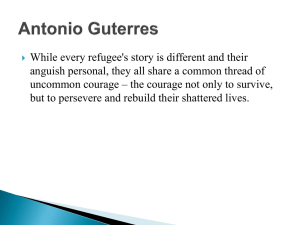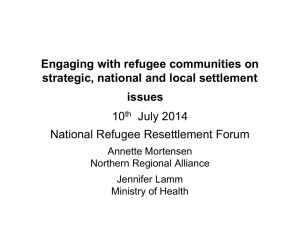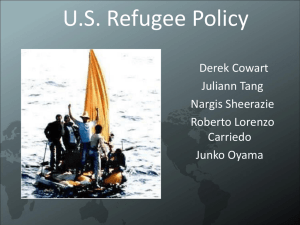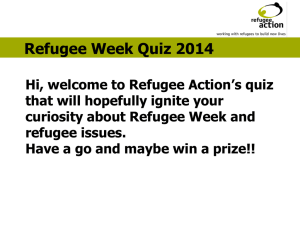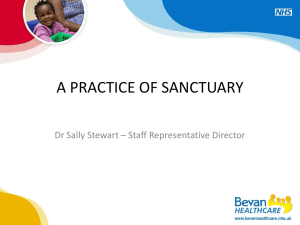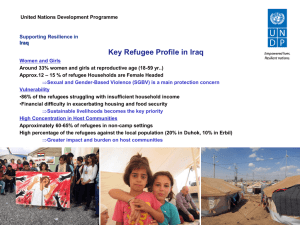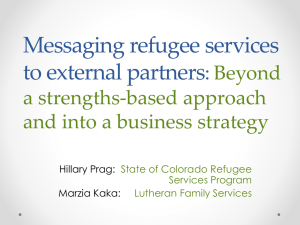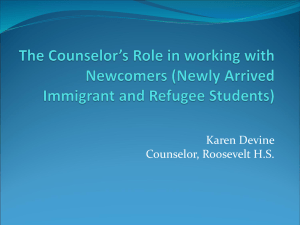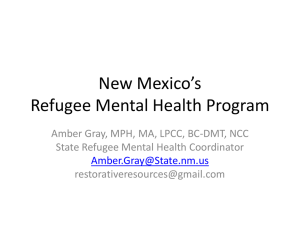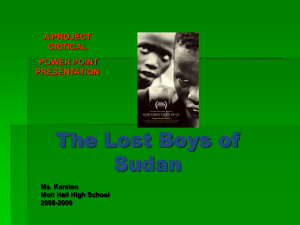Refugee Health Buffalo NY - School of Public Health and
advertisement
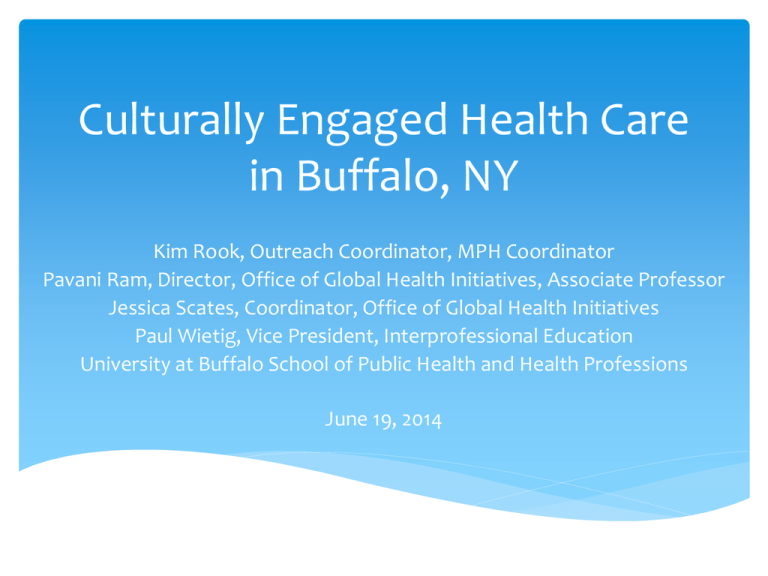
Culturally Engaged Health Care in Buffalo, NY Kim Rook, Outreach Coordinator, MPH Coordinator Pavani Ram, Director, Office of Global Health Initiatives, Associate Professor Jessica Scates, Coordinator, Office of Global Health Initiatives Paul Wietig, Vice President, Interprofessional Education University at Buffalo School of Public Health and Health Professions June 19, 2014 Arrivals by State for the Reporting Period of 1-October-2013 through 30-April-2014Data Texas 3888 California 3237 New York 2256 Data extracted from the Worldwide Refugee Admissions Processing System (WRAPS) Refugees resettled in New York State Total: 3829 *Federal Fiscal Year 2013 New York State Bureau of Refugee and Immigrant Assistance Sites of Refugee Resettlement in NY Erie County welcomes 36% of refugees in New York State! *Federal Fiscal Year 2013 New York State Bureau of Refugee and Immigrant Assistance Background and Objectives • Refugee health in Buffalo • UB/Community engagement • Refugee Health Summit State department of health University Medicaid County department of health Resettlement agency Funding organizations Refugee Insurers Medical specialists Refugee leaders Primary care providers Community organizations State bureau of refugee and immigrant assistance Health Needs & Gaps Health needs to address Lead poisoning Trauma and torture STIs/STDs Tuberculosis Diabetes Cancer Mental illness – depression Suicide Other chronic conditions Planning Committee Members Education Health Department Buffalo Public Schools New York State Department of Health Refugee Community Support University at Buffalo Burmese Community Support Center Global Health Initiative GSA H.E.A.L. International Office of Global Health Initiatives Resettlement Agencies Office of Interprofessional Education Catholic Charities of Buffalo Office of Public Health Practice Jewish Family Service of Buffalo & Erie County School of Dental Medicine Journey’s End Refugee Services, Inc. School of Management International Institute of Buffalo School of Medicine & Biomedical Sciences Primary Care Provision and Health Assessments School of Nursing Community Health Center of Buffalo School of Pharmacy and Pharmaceutical Sciences Jericho Road Community Health Center School of Public Health & Health Professions Neighborhood Health Center School of Social Work Refugee Health Summit Goal: Examine barriers and explore solutions to culturally engaged health care provision for refugees in Buffalo Objectives: • Describe existing barriers of culturally engaged health care provision for stakeholder groups in WNY • Learn about successful models to providing engaged health care for refugees in Buffalo and beyond • Identify potential linkages and spark collaborations to adapt and implement solutions to expand culturally engaged health care for refugees in Buffalo Summit Program 12:30-1:00 1:00-2:00 2:00-3:00 3:00-4:00 4:00-4:30 4:45-5:00 5:30-6:30 6:30-7:15 7:15-7:30 Introduction Panel Share Fair Informational talks Next steps Dinner Breakout groups Large group reporting and discussion Closing Panelists Bishnu Adhikari Employment Specialist, Journey’s End Refugee Services, Inc. Refugees Resettlement agencies Providers State Denise Phillips Beehag Director of Refugee and Employment Services, International Institute of Buffalo Cheryl Brown Refugee Health Program, Public Health Representative II, New York State Department of Health, Western Region Oma Chapagain Bhutanese Nepali Community Member Dianne M. Loomis Associate Clinical Professor, School of Nursing, Department of Family Medicine, University at Buffalo Chan Myae Thu Client Services Coordinator, Burmese Community Support Center Culture Language Trust Interpretation Religion Gender Definitions of good and poor health Health as a priority Preventive health vs. curative Accessing personal health information Accessing preventive care Accessing knowledge about prevention Translating medical terms Non-verbal language Many other issues as well… Mental health History of trauma The doctor and other ‘authority’ figures Power within the family Barriers to Healthcare • • • • • • Access to medical care (primary care) Cultural unfamiliarity among providers Grouping refugees into one generalizable group Health insurance Language Mental health and screening Informational Talks Dr. Myron Glick Dr. Kim Griswold Jim Sutton, RPA-C Models for Community Engagement & Care • Rochester Model - RSMI – Remote Simultaneous Medical Interpreting - Empowered oversight committee - Coordinated providers and care - Jericho Road Community Health Care Model - Hire a diverse staff, encourage diversity - Invest in community relationships - Built walk-ins into the system Models for Community Engagement & Care • Mental Health Provision • Train bi-lingual / bi-cultural mental health care providers • Adjust screening methods • Increase mental health value among refugees • Ethnic community support groups - Burmese Community Support Center - Others: Bhutanese Iraqi Breakouts to Address Barriers • Coordination of stakeholders • Mentorship of providers • Mobilizing human capital / leadership among refugee community • Interpretation • Improving linkages of care, addressing gaps in care Solutions to Barriers • Coordination of stakeholders Day-to-day agency partnerships through agreements Community-based steering committee or council Annual summit to reassess Culturally engaged healthcare assessment available online • Provider mentorship, education Referral / map app and web based resources Hiring of bilingual health providers and front office staff Relocate specialists to primary care locations Culturally engaged health care grand rounds Solutions to Barriers • Refugee mentorship, education, leadership Platform for ethnic community-based support organizations Identify leaders in the community for continued education training • Interpreter services RSMI (UN-like headsets) Interpretation phone apps Hire local community members and bi-lingual employees Web-based portal with language resources Educate providers in second languages Solutions to Barriers • Improving linkages of care, addressing gaps Health-e-Link health assessment Mental health providers in community health centers Mapping system addressing transportation issues Referral / map app Agency partnerships Health education – preventive care Takeaways • 110 registrants, 130 participants • 30 agencies and University Schools • Collaborations among agencies and refugee maximizes resources • Meaningful interagency relationships • Task forces and action plans created • UB will be leader in steering committee, exploration of interpretation models, among other areas Takeaways • • • • • Improving Linkages of Care (10) Mentorship of Providers (15) Coordination of Stakeholders (7) Mobilizing of Human Capital (4) Interpretation (5) Next Steps • • • • Dissemination of Refugee Health Summit Report Exploratory meeting with Refugee Advocates (June) Task force development Health for Refugee Populations Course Next Steps • Solidify University at Buffalo’s role moving forward • • • • • • School of Pharmacy continuing education School of Social Work build capacity and linkages School of Public Health provide field placement IT involvement Recruitment of talent from the refugee community Best practice research and assessments Acknowledgements: Thank You Office of Global Health Initiatives Dr. Pavani Ram Jessica Scates Dr. Arthur Goshin School of Public Health and Health Professions UB Office of Interprofessional Education Dr. Paul Wietig Community Agencies
